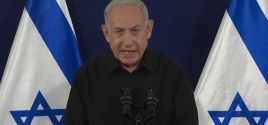Torture as American as apple piePhillip AdamsThe Austalian Mar. 21, 2006 |
Popular 
Claim Jewish Student Was 'Stabbed In The Eye' by Pro-Palestine Protester Draws Mockery After Video Released

Mistrial Declared in Case of Arizona Rancher Accused of Killing Migrant Trespasser

Sen. Hawley: Send National Guard to Crush Pro-Palestine Protests Like 'Eisenhower Sent the 101st to Little Rock'

Senate Passes $95B Giveaway to Israel, Ukraine, and Taiwan, Combined With TikTok Ban

AP: 'Israeli Strikes on Gaza City of Rafah Kill 22, Mostly Children, as U.S. Advances Aid Package'
 HAVING volunteered for active duty in Iraq, we are complicit in what happened in Abu Ghraib. Having left Australians to the tender mercies of US interrogators in Guantanamo Bay we're complicit in what has happened there. As an uncritical supporter of George W. Bush's war on terror, we are complicit in the widespread torturing of countless detainees. But for the purpose of today's column, based on Alfred McCoy's A Question of Torture: CIA Interrogation from the Cold War to the War on Terror (Metropolitan Press) and on conversations with the author through several years, let us focus on Abu Ghraib. We've been assured that the abuses in Saddam Hussein's favourite prison were isolated incidents by bad apples. In The New York Times William Safire blamed them on creeps. US Defence Secretary Donald Rumsfeld talked of "a few people on the night shift". Or the perpetrators are dismissed as recycled hillbillies from Maryland. But when McCoy saw those infamous photos, he recognised the hoods and the eerie poses as "textbook trademark CIA interrogation techniques; self-inflicted pain and sensory deprivation". He starts his story in the 1950s, when the CIA ran a large research effort, "a veritable Manhattan Project of the mind", spending a billion a year to crack the code of human consciousness. "They tried LSD, electroshock, sodium pentothal, mescaline, and they didn't work. Then they outsourced the research to Yale, Harvard and Princeton, but the breakthrough came from McGill [Canada]." A Donald Hebb found a form of torture far more effective than drugs or beatings. He could induce a state of psychosis within 48 hours, even in the healthy, well-adjusted students who volunteered to be guinea pigs. "By sitting them in a cubicle with goggles, gloves and headphones, cut off from their senses and sensory stimulation, they soon suffered hallucinations and then breakdown." The CIA also studied the Soviet approach. The KGB's most effective technique: self-inflicted pain. "Simply make someone stand for a day or two. You're not beating them; you say, 'You're doing this to yourself ... co-operate and you can sit down."' Combining the KGB technique with Hebb's discoveries produced a distinctively American style of torture, detailed by the CIA in their KUBARK counterintelligence manual. Refined in the field during the Kennedy years, in Central America and Southeast Asia, the approach was marketed by John F. Kennedy's Office of Public Safety. By 1971 over a million police officers in 47 nations had been trained, including 85,000 in South Vietnam and 100,000 in Brazil. It is well known that the toughest nuts don't crack under old-style torture. If the ideological motivation is strong enough, they'll martyr themselves. And confessions elicited through beatings are notoriously unreliable. So war on terror excuses - that torture can be justified if there's an urgent threat, perhaps a dirty bomb hidden in Los Angeles, the sort of plot familiar to the viewers of 24 - are simply wrong. The cognoscenti of interrogation know that the sympathetic "I'm your pal" approach is far more effective. As is sensory deprivation and self-inflicted pain. Remember the hoods in Abu Ghraib? Remember the man standing, arms outstretched? Scoffing at the agonies induced by this "distinctively American style of torture" Rumsfeld wrote a notorious memo: "I stand at my desk for eight hours a day, why are we limiting standing positions to only four hours a day?" The man who may be the next Republican president of the US, senator John McCain, was unamused. (McCain, remember, was wrecked by Vietcong torture over several years.) He pushed for the Detainee Treatment Act recently passed by Congress only to see it diluted and distorted by the White House. Now it's full of loopholes. The word severe is one of them. "Bush insists that severe means equivalent to organ failure," McCoy says. "In other words, right up to the point of death." Bush says: "I reserve the right as commander-in-chief to do what I need to do to defend America." He has given the CIA carte blanche to continue torturing, also coming up with a "Pacific solution" argument he might have borrowed from his friend John Howard. For the purpose of the McCain bill, Guantanamo Bay is excised from US territory. The same applies, of course, to the vast number of "black sites" the US has arranged for the specific purpose of torture across the world. With an Australian at Guantanamo, did the PM take up torture with Condoleezza Rice during last week's visit? Did Kim Beazley? In Europe, she was confronted with the torture issue by leaders, including the new leader of Germany, but I very much doubt that happened here. And if not, why not? Our country is deeply involved in a widening horror, and David Hicks is one of its victims. |



